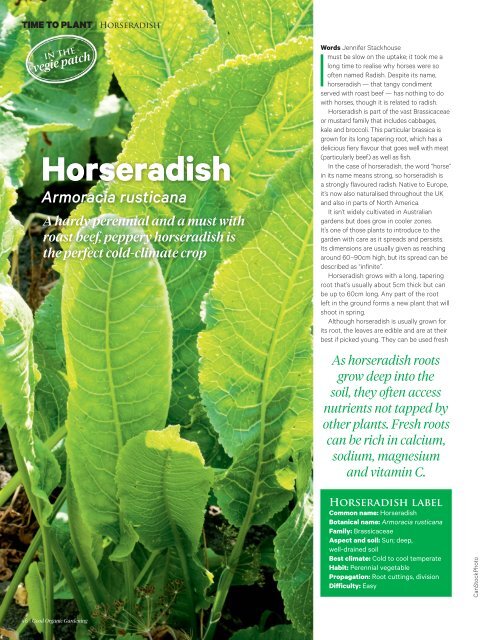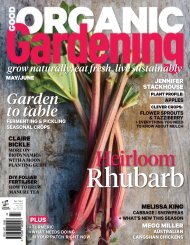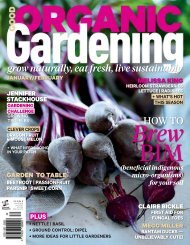5. Good Organic Gardening - September-October 2016 AvxHome.in
5. Good Organic Gardening - September-October 2016 AvxHome.in
5. Good Organic Gardening - September-October 2016 AvxHome.in
You also want an ePaper? Increase the reach of your titles
YUMPU automatically turns print PDFs into web optimized ePapers that Google loves.
TIME TO PLANT | Horseradish<br />
- <strong>in</strong> the -<br />
vegie patch<br />
Horseradish<br />
Armoracia rusticana<br />
A hardy perennial and a must with<br />
roast beef, peppery horseradish is<br />
the perfect cold-climate crop<br />
I<br />
Words Jennifer Stackhouse<br />
must be slow on the uptake; it took me a<br />
long time to realise why horses were so<br />
often named Radish. Despite its name,<br />
horseradish — that tangy condiment<br />
served with roast beef — has noth<strong>in</strong>g to do<br />
with horses, though it is related to radish.<br />
Horseradish is part of the vast Brassicaceae<br />
or mustard family that <strong>in</strong>cludes cabbages,<br />
kale and broccoli. This particular brassica is<br />
grown for its long taper<strong>in</strong>g root, which has a<br />
delicious fiery flavour that goes well with meat<br />
(particularly beef) as well as fish.<br />
In the case of horseradish, the word “horse”<br />
<strong>in</strong> its name means strong, so horseradish is<br />
a strongly flavoured radish. Native to Europe,<br />
it’s now also naturalised throughout the UK<br />
and also <strong>in</strong> parts of North America.<br />
It isn’t widely cultivated <strong>in</strong> Australian<br />
gardens but does grow <strong>in</strong> cooler zones.<br />
It’s one of those plants to <strong>in</strong>troduce to the<br />
garden with care as it spreads and persists.<br />
Its dimensions are usually given as reach<strong>in</strong>g<br />
around 60–90cm high, but its spread can be<br />
described as “<strong>in</strong>f<strong>in</strong>ite”.<br />
Horseradish grows with a long, taper<strong>in</strong>g<br />
root that’s usually about 5cm thick but can<br />
be up to 60cm long. Any part of the root<br />
left <strong>in</strong> the ground forms a new plant that will<br />
shoot <strong>in</strong> spr<strong>in</strong>g.<br />
Although horseradish is usually grown for<br />
its root, the leaves are edible and are at their<br />
best if picked young. They can be used fresh<br />
As horseradish roots<br />
grow deep <strong>in</strong>to the<br />
soil, they often access<br />
nutrients not tapped by<br />
other plants. Fresh roots<br />
can be rich <strong>in</strong> calcium,<br />
sodium, magnesium<br />
and vitam<strong>in</strong> C.<br />
Horseradish label<br />
Common name: Horseradish<br />
Botanical name: Armoracia rusticana<br />
Family: Brassicaceae<br />
Aspect and soil: Sun; deep,<br />
well-dra<strong>in</strong>ed soil<br />
Best climate: Cold to cool temperate<br />
Habit: Perennial vegetable<br />
Propagation: Root cutt<strong>in</strong>gs, division<br />
Difficulty: Easy<br />
CanStockPhoto<br />
46 | <strong>Good</strong> <strong>Organic</strong> <strong>Garden<strong>in</strong>g</strong>

















